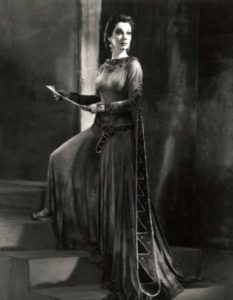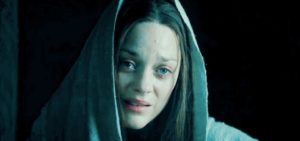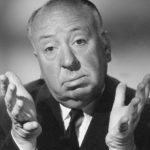Sympathy For The Devils: Reinterpreting the Macbeths – Miss Morris

The latest film version of Macbeth invites us to view these canonical villains in a more sympathetic light
Blood. Bewitchment. Betrayal. Shakespeare’s tale of intrigue, corruption and a man’s fall from grace has, for centuries, provided us with textbook examples of villainy in its protagonist, Macbeth, and his conniving wife. Famous productions have portrayed them as archetypal malefactors – focusing on the selfishness and evil that drives their actions. Take, for example, Laurence Olivier and Vivien Leigh’s production of Macbeth – Peggy Ashcroft, one of Leigh’s contemporaries, considered her performance of Lady Macbeth the best she had ever seen. Playing on her glacial beauty, and emphasising her physicality with a figure-hugging green dress, Leigh’s Lady Macbeth was both mesmerising and Machiavellian, persuading her husband to commit murder in a production which critics praised; the actress Maxine Audley, who played Lady Macduff, stated that, in Olivier and Leigh, the audience could truly believe these characters were married (Olivier and Leigh were married in real life.)

Vivien Leigh’s portrayal of Lady Macbeth
A more recent production, with Patrick Stewart in the lead role, played heavily on the comparisons to be drawn between Shakespeare’s despotic leader and C20th tyrants such as Hitler and Stalin. Older, wearier and seemingly without any redeeming features, Stewart’s Macbeth barely blinks, in a chilling, almost reptillian performance that invites no sympathy whatsoever for his character; if anything, we are relieved when Macduff holds his severed head aloft to Malcolm at the climax of the film. This 2010 production drew heavily on
This 2010 production drew heavily on
imagery from the darker moments in C20th history
So then; we might be forgiven for thinking that these two characters are irredeemably steeped in evil – ‘in blood stepped so far’ as to be beyond redemption or sympathy. Admittedly, Polanksi’s controversial 1971 film, with its younger, fresher central actors, could be seen as a departure from other productions. Francesca Annis, in particular, drew on aspects of Lady Macbeth’s vulnerability which may not have featured so prominently in other productions – literally baring all in her naked sleepwalking scene, for example.
However, Justin Kurzel’s 2015 production, starring Michael Fassbender and Marion Cotillard in the leading roles, takes the characters in a new direction, positively inviting the audience to feel sympathy for them. Kurzel doesn’t excuse their actions; the bloody death of Duncan is enacted on the screen in visceral detail, and Cotillard, like Leigh, has a coldness in her demeanour at times which can alienate us from her. But Kurzel does something bold in the opening scene of this production; we see a weeping Lady Macbeth and a broken Macbeth at the burial of their child, establishing visually what the text alludes to – the death of a child which drives Lady Macbeth’s ambition and gnaws away at the heirless Macbeth.

A moment of tenderness for the grieving couple
Kurzel’s 2015 vision presents very C21st themes and ideas. Fassbender stated in a Guardian interview:
“Never did it occur to me before this that this character was suffering from PTSD,” (Fassbender) said. “You have a soldier who’s engaged in battle month-after-month, day-after-day. Killing with his hands. Pushing a sword through muscle and bone. And if that doesn’t work picking up a rock and using that”.
He is haunted by the death of a young soldier in the opening battle – with the ghost of this character leading him to the sleeping Duncan later. Fassbender’s portrayal of Macbeth’s descent into madness is brutally, devastatingly captured; when he tells Cotillard’s Lady Macbeth ‘O, full of scorpions, is my mind, dear wife’, that wide grin of despair is marred by a falling tear. His death, when it comes, is an ambiguous resolution for the audience – it is difficult not to feel some pity for this man, monstrous as his acts have been, as he realises the witches’ betrayal, and launches himself into a futile and doomed battle with Macduff. The closing shots, which include soldiers simply walking past his corpse, leave the viewer with conflicting feelings; the greatness of the man is undeniable, despite his flaws, but perhaps Fassbender’s triumph in the role stems from so powerfully capturing his tortured humanity.

Macbeth prepares for his showdown with Macduff
Finally, to Lady Macbeth. Cotillard is quietly spoken throughout, her breathy French accent lending a touch of the exotic to the doomed Queen. In Fassbender and Cotillard, you can believe in an emotional and physical connection; there are moments of both sexual excitement and emotional tenderness for the characters in this production, and Macbeth’s words to his dead wife after her suicide are delivered with a genuine air of grief. But it is Cotillard, in her depiction of maternal mourning and mental deterioration, who really packs an emotional punch; her emotionally broken words to her hallucinated dead child are affecting, and Kurzel’s ambiguous ending for her, wandering alone and dishevelled towards the witches across the bleak moorland, suggests that she seeks not only a release from her guilt and mental torment, but to be reunited with her lost child.

A distraught Lady Macbeth addresses her dead child
In conclusion, this production meshes the original text with a very modern C21st reading; it offers clear reasons for the destructive forces which drive both characters, and does so in a visually stunning vision of C11th Scotland. As the GCSE approaches for Year 11, this study of mental frailty, guilt and self-destruction is a timely reminder of the continuing power of this play, and an opportunity to rethink our readings of these (in)famous literary villains.















Post Comment
You must be logged in to post a comment.